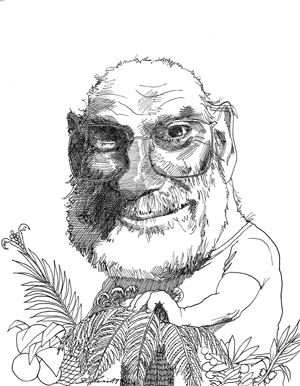In January 1946, when I was twelve and a half, I moved from my prep school in Hampstead, The Hall, to a much larger school, St. Paul’s, in Hammersmith. It was here, in the Walker Library, that I met Jonathan Miller for the first time. I was hidden in a corner, reading a nineteenth-century book on electrostatics—reading, for some reason, about “electric eggs”—when a shadow fell across the page. I looked up and saw an astonishingly tall, gangling boy with a very mobile face, brilliant, impish eyes, and an exuberant mop of reddish hair. We got talking together, and have been close friends ever since.
Prior to this time, I had had only one real friend, Eric Korn, whom I had known almost from birth. Eric followed me from The Hall to St. Paul’s a year later, and now he and Jonathan and I formed an inseparable trio, bound not only by personal but by family bonds too (our fathers, thirty years earlier, had all been medical students together, and our families had remained close). Jonathan and Eric did not really share my love of chemistry—though a year or two earlier they had joined me in a flamboyant chemical experiment: throwing a large lump of metallic sodium into the Highgate Ponds on Hampstead Heath, and watching excitedly as it took fire and sped round and round on the surface like a demented meteor, with a huge sheet of yellow flame beneath it—but they were intensely interested in biology, and it was inevitable, when the time came, that we would find ourselves together in the same biology class, and that all of us would fall in love with our biology teacher, Sid Pask.
Pask was a splendid teacher. He was also narrow-minded, bigoted, cursed with a hideous stutter (which we would imitate endlessly), and by no means exceptionally intelligent. By dissuasion, irony, ridicule, or force, he would turn us away from all other activities—from sport and sex, from religion and families, and from all our other subjects at school. He demanded that we be as single-minded as himself.
The majority of his pupils found him an impossibly demanding and exacting taskmaster. They would do all they could to escape from this pedant’s petty tyranny, as they regarded it. The struggle would go on for a while, and then suddenly there was no longer any resistance—they were free. Pask no longer carped at them, no longer made ridiculous demands upon their time and energy.
Yet some of us, each year, responded to Pask’s challenge. In return he gave us all of himself—all his time, all his dedication, for biology. We would stay late in the evening with him in the Natural History Museum (I once hid myself in a gallery and managed to spend the night there). We would sacrifice every weekend to plant-collecting expeditions. We would get up at dawn on freezing winter days to go on his January freshwater course. And once a year—there is still an almost intolerable sweetness about the memory—we would go with him to Millport for three weeks of marine biology.
Millport, off the western coast of Scotland, had a beautifully equipped marine biology station, where we were always given a friendly welcome and inducted into whatever experiments were going on. (Fundamental observations were being made on the development of sea urchins at this time, but Lord Rothschild, now in the midst of his soon-to-be-famous experiments on the fertilization of sea urchins, was endlessly patient with the enthusiastic schoolboys who crowded around and peered into his petri dishes with the transparent pluteus larvae.) Jonathan, Eric, and I made several transects on the rocky shore together, counting all the animals and seaweeds we could on successive square-foot portions of the lichen-covered summit of the rock (Xanthoria parietina was the euphonious name of this lichen) to the shoreline and tidal pools below. Eric was particularly and wittily ingenious, and once, when we needed a plumb line to give us a true vertical, but did not know how to suspend it, he pried a limpet from the base of a rock, placed the tip of the plumb line beneath it, and firmly reattached it at the top as a natural drawing pin.
We all adopted particular zoological groups: Eric became enamored of sea cucumbers, holothurians; Jonathan of iridescent bristled worms, polychaetes; and I of squids and cuttlefish, octopuses, cephalopods—the most intelligent and, to my eyes, the most beautiful of invertebrates. One day we all went down to the seashore, to Hythe in Kent, where Jonathan’s parents had taken a house for the summer, and went out for a day’s fishing on a commercial trawler. The fishermen would usually throw back the cuttlefish that ended up in their nets (they were not popular eating in England). But I, fanatically, insisted that they keep them for me, and there must have been dozens of them on the deck by the time we came in. We took all the cuttlefish back to the house in pails and tubs, put them in large jars in the basement, and added a little alcohol to preserve them. Jonathan’s parents were away, so we did not hesitate. We would be able to take all the cuttlefish back to school, to Pask—we imagined his astonished smile as we brought them in—and there would be a cuttlefish apiece for everyone in the class to dissect, two or three apiece for the cephalopod enthusiasts. I myself would give a little talk about them at the Field Club, dilating on their intelligence, their large brains, their eyes with erect retinas, their rapidly changing colors.
Advertisement
A few days later, the day Jonathan’s parents were due to return, we heard dull thuds emanating from the basement, and going down to investigate, we encountered a grotesque scene: the cuttlefish, insufficiently preserved, had putrefied and fermented, and the gases produced had exploded the jars and blown great lumps of cuttlefish all over the walls and floor; there were even shreds of cuttlefish stuck to the ceiling. The intense smell of putrefaction was awful beyond imagination. We did our best to scrape off the walls and remove the exploded, impacted lumps of cuttlefish. We hosed down the basement, gagging, but the stench was not to be removed, and when we opened windows and doors to air out the basement, it extended outside the house as a sort of miasma for fifty yards in every direction.
Eric, always ingenious, suggested we mask the smell, or replace it, by an even stronger, but pleasant, smell—a coconut essence, we decided, would fill the bill. We pooled our resources and bought a large bottle of this, which we used to douche the basement, and then distributed liberally through the rest of the house and its grounds.
Jonathan’s parents arrived an hour later and, advancing toward the house, hit an overwhelming scent of coconut. But as they drew nearer they hit a zone dominated by the stench of putrefied cuttlefish—the two smells, the two vapors, for some curious reason, had organized themselves in alternating zones about five or six feet wide. By the time they reached the scene of our accident, our crime, the basement, the smell was insupportable for more than a few seconds. The three of us were all in deep disgrace over the incident. I especially, since it had arisen from my greed in the first place (would not a single cuttlefish have done?) and my folly in not realizing how much alcohol they would need. Jonathan’s parents had to cut short their holiday and leave the house (the house itself, we heard, remained uninhabitable for months). But my love of cuttlefish remained unimpaired.
Perhaps there was a chemical reason for this, as well as a biological one, for cuttlefish (like many other molluscs and crustaceans) have blue blood, not red, because they evolved a completely different system for transporting oxygen from the one we vertebrates had. Whereas our red respiratory pigment, hemoglobin, contains iron, their bluish-green pigment, hemocyanin, contains copper. Iron and copper each have two different “oxidation states,” and this means that they can easily take up oxygen in the lungs, move it to a higher oxidation state, and then relinquish it, in the tissues, as needed. But why employ just iron and copper, when there was another metal—vanadium, a neighbor of theirs in the periodic table—which had no less than four oxidation states? I wondered if vanadium compounds were ever exploited as respiratory pigments, and got most excited when I heard that some sea squirts, tunicates, were extremely rich in the element vanadium, and had special cells, vanadocytes, devoted to storing it. Why they contained these was a mystery; they did not seem to be part of an oxygen-transport system.
Absurdly, impudently, I thought I might solve this mystery during one of our annual excursions to Millport. But I got no further than collecting a bushel of sea squirts (with the same greed, the same inordinacy, that had caused me to collect too many cuttlefish). I could incinerate these, I thought, and measure the vanadium content of their ash (I had read that this could exceed 40 percent in some species). And this gave me the only commercial idea I have ever had: to open a vanadium farm—acres of sea meadows, seeded with sea squirts. I would get them to extract the precious vanadium from seawater, as they had been doing very efficiently for the last 300 million years, and then sell it for £500 a ton. The only problem, I realized, aghast at my own genocidal thoughts, would be the veritable holocaust of sea squirts required.
Advertisement
This Issue
October 18, 2001




